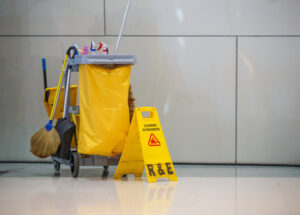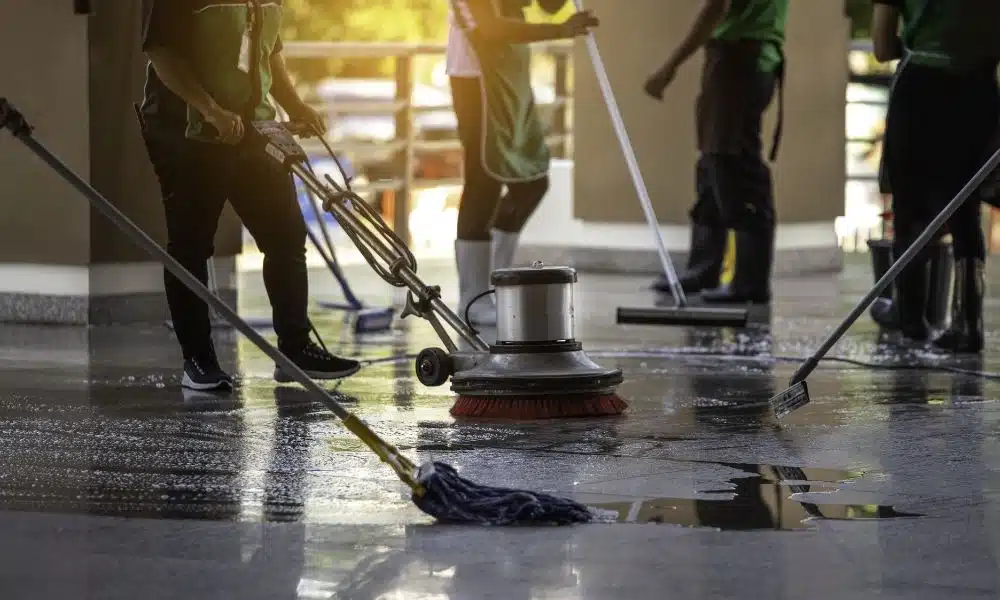The commercial cleaning industry is evolving rapidly, driven by technological advancements, sustainability concerns, and changing client expectations. As we look ahead to 2025, several key trends are set to shape the future of commercial cleaning. Staying ahead of these trends will help cleaning businesses remain competitive and meet the growing demands of their clients.

Commercial Cleaning
1. Rise of Automation and Robotics
Automation and robotics are revolutionizing the commercial cleaning industry, offering efficient and cost-effective solutions. Robotic cleaners, such as autonomous vacuum cleaners and floor scrubbers, are becoming more prevalent in large commercial spaces. These machines can work around the clock, reducing the need for manual labor and improving overall cleaning efficiency.
- Advantages of Robotics: Robots can perform repetitive tasks consistently without fatigue, lowering labor costs and increasing productivity. They also reduce human exposure to hazardous environments, enhancing workplace safety.
- Integration with IoT: The integration of robotics with the Internet of Things (IoT) allows for real-time monitoring and control of cleaning operations. Smart sensors and data analytics can optimize cleaning schedules, track equipment performance, and predict maintenance needs, ensuring a more efficient and effective cleaning process.
2. Increased Demand for Green Cleaning Solutions
As sustainability becomes a top priority for businesses and consumers alike, the demand for green cleaning solutions is on the rise. Companies are seeking eco-friendly cleaning products and practices that minimize environmental impact while maintaining high cleanliness standards.
- Eco-Friendly Products: Biodegradable and non-toxic cleaning agents are becoming more popular, as they reduce indoor air pollution and are safer for both cleaning staff and occupants. Businesses are also looking for cleaning products with certifications like Green Seal and EcoLogo, which ensure adherence to strict environmental standards.
- Sustainable Practices: Beyond using green products, commercial cleaning companies are adopting sustainable practices such as water conservation, waste reduction, and energy-efficient cleaning methods. This holistic approach to sustainability is becoming a key differentiator in the industry.
3. Focus on Health and Hygiene
The COVID-19 pandemic has heightened awareness of the importance of cleanliness and hygiene in commercial spaces. This trend is expected to continue, with businesses prioritizing health and hygiene to ensure the safety of employees and customers.
- Enhanced Disinfection Protocols: Regular disinfection of high-touch surfaces, air purification, and the use of antimicrobial coatings are becoming standard practices. Businesses are also investing in technologies like UV-C light disinfection and electrostatic sprayers to enhance cleaning efficacy.
- Healthy Building Certifications: More businesses are seeking certifications like WELL Building Standard and Fitwel, which emphasize health and wellness in building design and maintenance. Achieving these certifications requires a commitment to stringent cleaning and hygiene standards.
4. Adoption of Digital Tools and Software
Digital transformation is reshaping the commercial cleaning industry, with companies adopting software and tools to streamline operations, improve service delivery, and enhance customer experience.
- Cleaning Management Software: Software solutions for scheduling, reporting, and quality control are becoming essential tools for cleaning companies. These platforms offer real-time visibility into cleaning operations, enabling managers to monitor performance, track compliance, and quickly address any issues.
- Customer Portals and Mobile Apps: Providing clients with access to digital portals or mobile apps enhances communication and transparency. Clients can request services, provide feedback, and track service delivery, improving overall satisfaction and retention.
5. Emphasis on Employee Training and Well-Being
The role of cleaning staff has become more critical in maintaining health and safety standards, leading to an increased focus on training and well-being.
- Advanced Training Programs: Companies are investing in comprehensive training programs to equip employees with the skills needed to use advanced cleaning equipment, handle hazardous materials, and follow enhanced disinfection protocols.
- Employee Wellness Initiatives: Recognizing the importance of a healthy workforce, cleaning companies are implementing wellness initiatives such as ergonomic training, mental health support, and providing personal protective equipment (PPE) to ensure employee safety and well-being.
6. Expansion of Specialized Cleaning Services
As businesses become more aware of specific cleaning needs, there is a growing demand for specialized cleaning services.
- Sector-Specific Cleaning: Different sectors, such as healthcare, hospitality, and education, require tailored cleaning solutions that adhere to sector-specific regulations and standards. Companies are developing expertise in these areas to offer targeted services that meet client needs.
- High-Level Disinfection Services: The demand for high-level disinfection services, particularly in healthcare and food industries, is increasing. These services go beyond standard cleaning to eliminate pathogens and reduce the risk of contamination, ensuring a safer environment.
Conclusion
The commercial cleaning industry is poised for significant growth and transformation in the coming years. By staying ahead of emerging trends such as automation, green cleaning, enhanced hygiene protocols, digital tools, employee training, and specialized services, businesses can remain competitive and meet the evolving demands of their clients. As the industry continues to innovate and adapt, those who embrace these changes will be well-positioned for success in 2025 and beyond.


Recent Comments